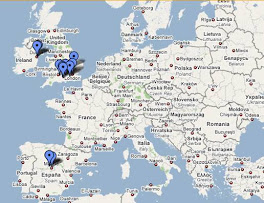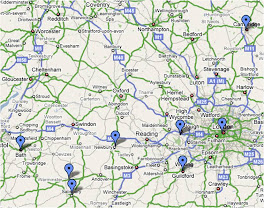For the first time since September, Bill and I found ourselves with an unusual phenomenon: a free weekend. With crazy travel schedules filled to capacity with train rides and early morning flights, I was thankful for the chance to catch my breath! Though we had no plans or pre-scheduled trains to catch, we couldn't stop ourselves from taking at least one day trip to see another of England's most famous sights -- Stonehenge.
If you ask an American for their thoughts on Stonehenge, they'll begin dancing around the room singing praises of this unique stone remnant of ancient times. If you mention Stonehenge to a Brit, however, they'll typically roll their eyes, pull up a picture on the internet, and say, "Now you've seen it." Living in England for over two months now, I can understand both points of view. Not wanting to discredit the famous sight, Bill and I decided to see the rocks for ourselves to form our own opinion.
Hopping on a train bound for the nearby city of Salisbury, we arrived with plenty of time to catch the first Stonehenge tour bus of the day. Listening to the tour guide give a lively narration on the history of Salisbury, I kept my eyes peeled for my first view of the ancient rocks. Catching a glimpse of them in the distance, I experienced what most Americans feel when they first see Stonehenge -- slight disappointment. With pictures of Stonehenge plastered across British tour books and Microsoft desktop backgrounds, we tend to envision the stones as a massive altar to the all-powerful sun god. In reality, however, the rocks are rather compact and stretch only twelve feet high. Though twelve vertical feet is a decent height for an ancient man-made rock formation, it's difficult to gauge the size of the rocks from a mile away in a double-decker tour bus. Thankfully, Stonehenge grew more impressive as we walked closer to the stones.
Though visitors were allowed to climb on the stones in the past, Stonehenge is now restricted by a roped-off perimeter about 20-30 feet from the outermost rocks. Wanting to preserve the stones, I can't blame archaeologists for being protective of one of the world's greatest historic mysteries. Built nearly 3500 years ago, Stonehenge is thought to be a ritualistic monument built in honor of the sun god and earth goddess. Aligning perfectly with the heavens, the first rays of sunrise on the summer solstice (June 21) shine through the entrance of the horseshoe-shaped rock arrangement to shine on the earth goddess's stone in the center of the monument. This central rock was made from blue mica that shimmers when touched by sunlight. As the most romantic stone in the rock formation, the center stone represents the earth goddess that glimmers when her lover (the sun god) shines down upon her once a year on the summer solstice. The other rocks arranged around the goddess's stone are thought to function as an ancient calendar even though historians are unsure of their true purpose. Within several miles of the rocks, there are several burial mounds, which also leads archaeologists to believe that Stonehenge was part of a sacred cemetery. With so many questions left unanswered, Stonehenge remains mostly a mystery even today.
Satisfied with a few fun pictures of the rocks, we loaded back onto the tour bus for our return trip to Salisbury. A small town, Salisbury is one of the few cities in England left relatively untouched by World War II. Home to the highest steeple in England, the German military was commanded to do nothing that might harm Salisbury Cathedral. Though an important British Royal Air Force base was located nearby, German pilots needed the tall cathedral steeple as a landmark to determine their position in the air. Thanks to their prized medieval church, the people of Salisbury remained safe despite a devastating war.
Visiting the cathedral ourselves, Bill and I were pleasantly surprised to find that no admission fee was charged to visitors wanting to view the interior of the beautiful church. Accepting donations only, monetary contributions are spent towards a single common goal: keeping the steeple standing. Ironically, the original plans for the cathedral did not include a steeple. Designing only a high-ceilinged chapel, the architect ordered laymen to pour a foundation only four feet deep, which provided plenty of support for the original church design. The bishop, however, changed his mind on the plans after the foundation was built and ordered that the tallest steeple in England be added to the cathedral. Arguing that the foundations were not deep enough for such a tower, the architect eventually gave in to the bishop's demands and built a steeple on rather risky foundation. To keep the steeple standing, support arches were added to the church in hopes of keeping the tower in place. Unfortunately, the architect was right in arguing against a steeple with a shallow foundation -- the steeple shifts a few inches each year and requires constant attention even today.
As an added bonus to visiting to the Salisbury Cathedral, Bill and I were able to view one of only four remaining copies of the Magna Carta. Written in the thirteenth century, the Magna Carta is reportedly the world's first modern "bill of rights". The original document is displayed in the British Library in London, but three other copies are scattered across the United Kingdom. Serving as the basis for the Declaration of Independence and the U.S. Constitution, the Magna Carta was written in response to King John's disregard for British law. Declaring all men equal under the Church of England, the Magna Carta still managed to fall short of providing equal rights to women and non-Anglican religions. Nevertheless, it was at least a step in the right direction towards human equality.
With few other tourist sights to see in Salisbury, Bill and I were content to walk around the town square for a bit of Saturday shopping. Browsing through bulk candy stands and a few clothing shops, we eventually bagged our purchases and headed home for another low-key evening in Guildford. Though our weekend wasn't fanatically hectic, we both needed a few days to relax before tackling a few other European countries in November.
So where do our adventures lead us next?
MADRID, SPAIN!
Subscribe to:
Post Comments (Atom)











No comments:
Post a Comment